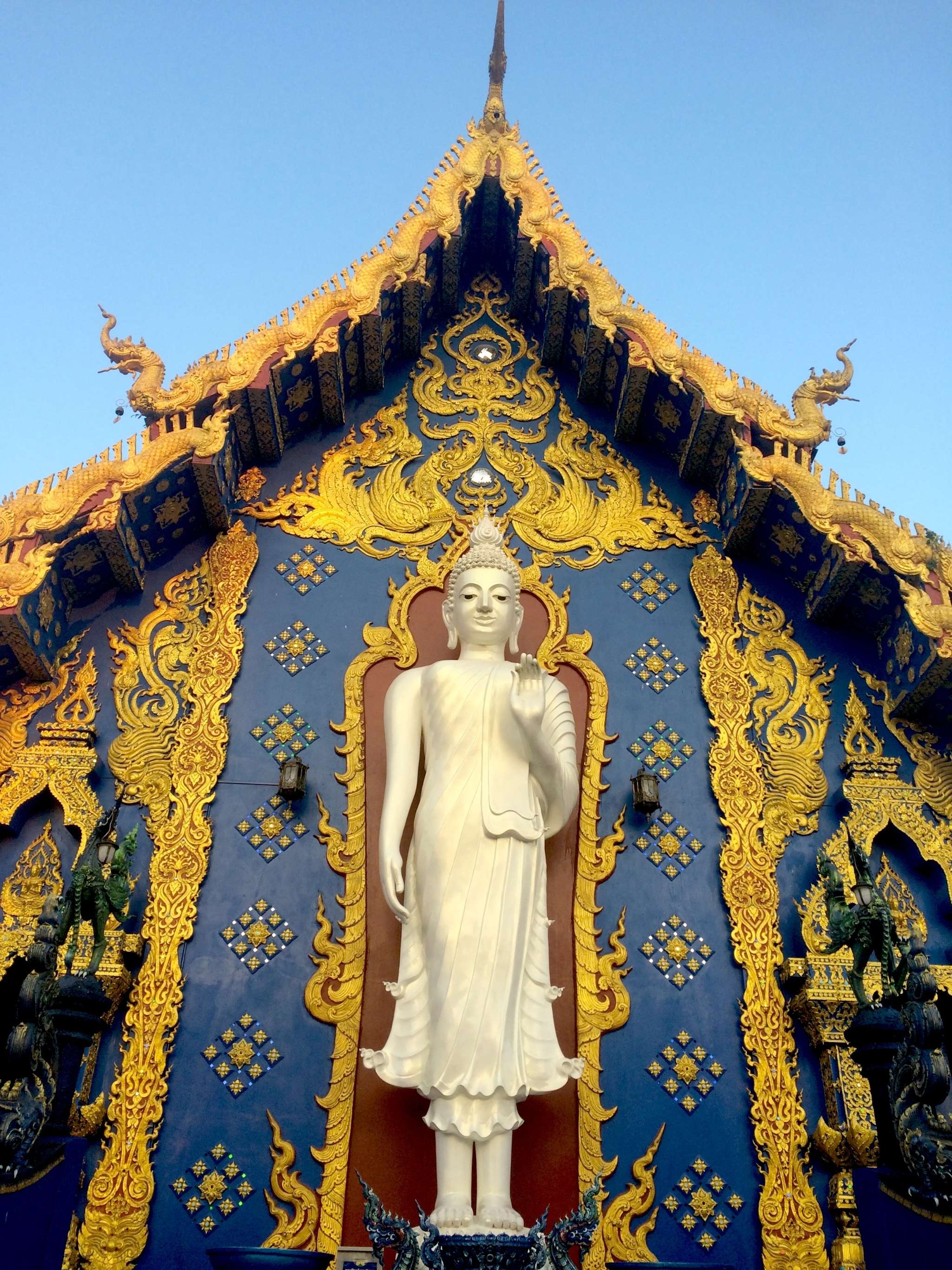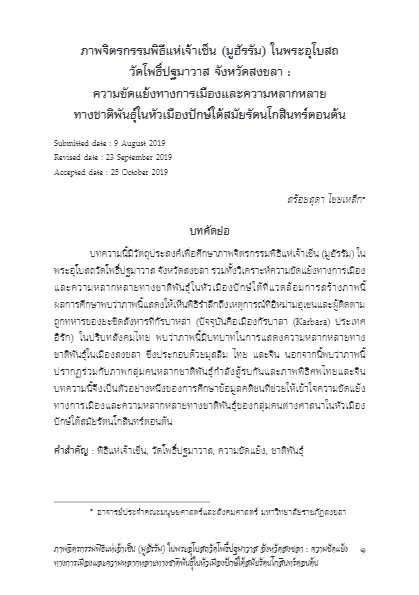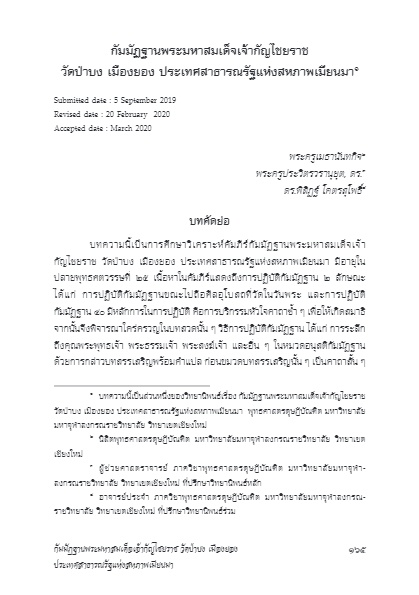ภาพจิตรกรรมพิธีแห่เจ้าเซ็น (มูฮัรรัม) ในพระอุโบสถวัดโพธิ์ปฐมาวาส จังหวัดสงขลา : ความขัดแย้งทางการเมืองและความหลากหลายทาง ชาติพันธุ์ในหัวเมืองปักษ์ใต้สมัยรัตนโกสินทร์ตอนต้น
ภาพจิตรกรรมพิธีแห่เจ้าเซ็น (มูฮัรรัม) ในพระอุโบสถวัดโพธิ์ปฐมาวาส จังหวัดสงขลา : ความขัดแย้งทางการเมืองและความหลากหลายทางชาติพันธุ์ในหัวเมืองปักษ์ใต้สมัยรัตนโกสินทร์ตอนต้น
สร้อยสุดา ไชยเหล็ก
บทคัดย่อ
บทความนี้มีวัตถุประสงค์เพื่อศึกษาภาพจิตรกรรมพิธีแห่เจ้าเซ็น (มูฮัรรัม) ในพระอุโบสถวัดโพธิ์ปฐมาวาส จังหวัดสงขลา รวมทั้งวิเคราะห์ความขัดแย้งทางการเมืองและความหลากหลายทางชาติพันธุ์ในหัวเมืองปักษ์ใต้ที่แวดล้อมการสร้างภาพนี้ ผลการศึกษาพบว่าภาพนี้แสดงให้เห็น
พิธีรำลึกถึงเหตุการณ์ที่อิหม่ามฮุเซนและผู้ติดตามถูกทหารของยะซีดสังหารที่กัรบาหล่า (ปัจจุบันคือเมืองกัรบาลา (Karbara) ประเทศอิรัก) ในปริบทสังคมไทย พบว่าภาพนี้มีบทบาทในการแสดงความหลากหลายทางชาติพันธุ์ในเมืองสงขลา ซึ่งประกอบด้วยมุสลิม ไทย และจีน นอกจากนี้พบว่าภาพนี้ปรากฏร่วมกับภาพกลุ่มคนหลากชาติพันธุ์กำลังสู้รบกันและภาพพิธีศพไทยและจีน บทความนี้จึงเป็นตัวอย่างหนึ่งของการศึกษาข้อมูลคติชนที่ช่วยให้เข้าใจความขัดแย้งทางการเมืองและความหลากหลายทางชาติพันธุ์ของกลุ่มคนต่างศาสนาในหัวเมืองปักษ์ใต้สมัยรัตนโกสินทร์ตอนต้น
คำสำคัญ : พิธีแห่เจ้าเซ็น, วัดโพธิ์ปฐมาวาส, ความขัดแย้ง, ชาติพันธุ์
(ตีพิมพ์ใน วารสารไทยศึกษา ปีที่ 16 ฉบับที่ 1 (มกราคม-มิถุนายน 2563) หน้า 1-33)
Chao Sen Procession (Muharram) Paintings in the Ubosot of Wat Pho Pathomawat in Songkhla Province: Political Conflicts and Ethnic Diversity in the Southern Region in the Early Bangkok Period
Soisuda Chailek
Abstract
This article aims to study the Chao Sen Procession (Muharram) paintings in the Ubosot of Wat Pho Pathomawat in Songkhla province and investigate political conflicts and ethnic diversity in the southern region of Thailand during the Early Bangkok period in which the paintings are contextualized. The study shows that the paintings illustrate a procession that commemorated the deaths of Imam Hussen and his followers slaughtered by Yasid I’s soldiers at Karbara. In the Thai context, the paintings illustrate ethnic diversity in Songkhla, including Muslim, Thai and Chinese culture. Furthermore, the paintings are related to ethnic group fighting paintings and Thai and Chinese funeral ceremony paintings. This article is an example of a study of folklore used to understand political conflicts and ethnic diversity of different beliefs in southern Thailand during the Early Bangkok period.
Keywords: Muharram, Wat Pho Pathomawat, conflict, ethnic
(Published in Journal of Thai Studies Volume 16 Number 1 (January-June 2020) Page 1-33)
บทความ/ fulltext : 1_Soisuda.pdf
พลวัตของคติชนเกี่ยวกับพระบรมธาตุเจดีย์ ในบริบทการนำเสนอวัดพระมหาธาตุวรมหาวิหาร เพื่อขึ้นทะเบียนเป็นมรดกโลก
พลวัตของคติชนเกี่ยวกับพระบรมธาตุเจดีย์ ในบริบทการนำเสนอวัดพระมหาธาตุวรมหาวิหาร เพื่อขึ้นทะเบียนเป็นมรดกโลก
พลกฤษณ์ วสีวิวัฒน์ และปรมินท์ จารุวร
บทคัดย่อ
บทความนี้มีวัตถุประสงค์เพื่อศึกษาพลวัตของคติชนเกี่ยวกับพระบรมธาตุเจดีย์ และวิธีคิดในการนำคติชนดังกล่าวมาใช้ในบริบทการนำเสนอวัดพระมหาธาตุวรมหาวิหาร จังหวัดนครศรีธรรมราช เพื่อขึ้นทะเบียนเป็นมรดกโลก ผลการศึกษาพบว่า การนำเสนอมรดกโลกเป็นปัจจัยสำคัญที่ทำให้มีการนำคติชนเกี่ยวกับพระบรมธาตุเจดีย์ในสังคมประเพณี เช่น ตำนานและเรื่องเล่า ความเชื่อ ประเพณีและพิธีกรรม มาใช้ในหลายลักษณะ ส่งผลให้เกิดพลวัตของคติชนในหลากหลายมิติ ได้แก่ คติชนเกี่ยวกับพระบรมธาตุเจดีย์ทำให้เกิดรูปเคารพและวัตถุมงคลใหม่ ๆ คติชนเกี่ยวกับพระบรมธาตุเจดีย์เป็นเครื่องมือในการต่อรองความสัมพันธ์เชิงอำนาจ คติชนเกี่ยวกับพระบรมธาตุเจดีย์กลายเป็นสินค้าวัฒนธรรม คติชนเกี่ยวกับพระบรมธาตุเจดีย์มีการนำเสนอผ่านกระบวนการวิชาการ และ คติชนเกี่ยวกับพระบรมธาตุเจดีย์ช่วยขยายความศรัทธาและทำให้เกิดสิ่งศักดิ์สิทธิ์ใหม่ ปรากฏการณ์นี้สะท้อน “วิธีคิดแบบคนใต้” ในลักษณะการสร้างเครือข่ายความสัมพันธ์แบบพวกพ้อง การพึ่งพาบารมีของพระบรมธาตุเจดีย์ การดัดแปลงให้เป็นของท้องถิ่น และการอิงรากทางวัฒนธรรม
คำสำคัญ : คติชนเกี่ยวกับพระบรมธาตุเจดีย์; พลวัตของคติชน; มรดกโลก
(ตีพิมพ์ใน วารสารไทยศึกษา ปีที่ 16 ฉบับที่ 1 (มกราคม-มิถุนายน 2563) หน้า 35-74)
Dynamics of Phra Borommathat Chedi folklore in the context of the nomination of Wat Phra Mahathat Woramahawihan to the World Heritage list
Pholkrit Waseewiwat and Poramin Jaruworn
Abstract
This article aims to study the dynamics of Phra Borommathat Chedi folklore and the ways of thinking of how to use folklore in the context of the nomination process of Wat Phra Mahathat Woramahawihan, Nakhon Si Thammarat Province, to the World Heritage List. The study reveals that the use of Phra Borommathat Chedi folklore, such as myths and narratives, beliefs, traditions and rituals in many forms in traditional society, is a main factor in the nomination to the World Heritage List. This has resulted in the use of Phra Borommathat Chedi folklore in various new dimensions. For example, Phra Borommathat Chedi folklore has created new icons and sacred objects, along with instruments to negotiate power relations, and has been transformed into a cultural commodity presented through the academization and expansion of faith and creation of new sacred objects. This phenomenon reflects “the ways of Southern people thinking”, including creating a relationship network, reliance upon the “barami” of Phra Borommathat Chedi, localization and references to cultural roots.
Keywords: Phra Borommathat Chedi folklore; dynamics of folklore; World Heritage
(Published in Journal of Thai Studies Volume 16 Number 1 (January-June 2020) Page 35-74)
บทความ/ fulltext : 2_Pholkrit.pdf
ภูมิปัญญาท้องถิ่นบ้านหินตั้ง ตำบลข้าวสาร อำเภอบ้านผือ จังหวัดอุดรธานี
ภูมิปัญญาท้องถิ่นบ้านหินตั้ง ตำบลข้าวสาร อำเภอบ้านผือ จังหวัดอุดรธานี
สุนิตย์ เหมนิล
บทคัดย่อ
บทความนี้มุ่งศึกษาบริบทชุมชน และการจัดการภูมิปัญญาท้องถิ่นบ้านหินตั้ง เพื่อนำไปสู่การเผยแพร่และรักษาภูมิปัญญาท้องถิ่นอีสาน โดยใช้วิธีการศึกษาเชิงคุณภาพ ผู้ให้ข้อมูลหลัก คือ ปราชญ์ชาวบ้าน ผู้นำและอดีตผู้นำชุมชน ผู้สูงอายุ และชาวบ้านหินตั้งที่อยู่ในพื้นที่ไม่น้อยกว่า ๒๐ ปี รวมจำนวน ๕๐ คน ส่วนเครื่องมือที่ใช้เก็บข้อมูลเป็นแบบสัมภาษณ์กึ่งโครงสร้างและการสัมภาษณ์เจาะลึก จัดระบบข้อมูล ตีความเชื่อมโยงความสัมพันธ์ และการนำเสนอผลการศึกษาด้วยวิธีการพรรณนาวิเคราะห์ ผลการศึกษาพบว่า บ้านหินตั้ง เป็นสังคมเกษตรกรรม ตั้งแต่อดีตจนถึงปัจจุบันชาวบ้านมีความเชื่อเรื่องพื้นที่ศักดิ์สิทธิ์และสิ่งเหนือธรรมชาติ เชื่อมโยงกับหลักพุทธศาสนา โดยเฉพาะความเชื่อเกี่ยวกับผีปู่ตาที่คอยปกปักรักษาลูกหลาน ส่วนด้านภูมิปัญญาของชาวบ้านมาจากฐานของสังคมเกษตรกรรม ผนวกกับการปลูกฝังและสืบทอดจากบรรพบุรุษ เป็นส่วนเกื้อหนุนสำคัญของบ่อเกิดภูมิปัญญาท้องถิ่นในหลายด้าน ซึ่งล้วนแต่เป็นประโยชน์ต่อตนเองและชุมชน และสามารถนำมาปรับใช้เป็นแนวทางการพัฒนาให้เกิดความมั่นคงทางเศรษฐกิจและสังคมได้อย่างยั่งยืน ดังนั้น จึงควรศึกษาและเผยแพร่ภูมิปัญญาท้องถิ่นอีสานให้คงอยู่สืบไป
คำสำคัญ: ภูมิปัญญาท้องถิ่น, ปราชญ์ชาวบ้าน, บ้านหินตั้ง
(ตีพิมพ์ใน วารสารไทยศึกษา ปีที่ 16 ฉบับที่ 1 (มกราคม-มิถุนายน 2563) หน้า 75-103)
Folk wisdom in Ban Hin Tang, Khao San Sub-district,Ban Phue District, Udon Thani Province
Sunit Hemanil
Abstract
This article aims to study the community context and folk wisdom management in Ban Hin Tang in order to propagate and preserve Esan folk wisdom. The study used a qualitative research method and fifty key informants comprising local wisdom scholars, community leaders, ex-community leaders, the elders and villagers who have lived in Ban Hin Tang over 20 years.
The research results found that Ban Hin Tang is an agricultural society. From past to present, the villagers believe in sacred spaces and the supernatural that can be related to the principles of Buddhism. In particular, the beliefs are related to ancestral spirits who are the guardians for their descendants. The villagers have received folk wisdom from being an agricultural society, combining preservation by ancestors, which is the key factor in the creation of folk wisdom in many ways. The folk wisdom benefits the villagers and their community. In addition, such wisdom can be applied for sustainable development in economic and social stability.
Keywords: Folk wisdom, local wisdom scholars, Ban Hin Tang
(Published in Journal of Thai Studies Volume 16 Number 1 (January-June 2020) Page 75-103)
บทความ/ fulltext : 3_Sunit.pdf
พระแท่น : พระพุทธศาสนา ความเชื่อ และวัฒนธรรมไทย
พระแท่น : พระพุทธศาสนา ความเชื่อ และวัฒนธรรมไทย
ปฐมพงษ์ สุขเล็ก
บทคัดย่อ
บทความนี้มุ่งนำเสนอความเชื่อเรื่องพระแท่น และการสักการบูชาในวัฒนธรรมไทย โดยศึกษาจากวรรณคดีจำนวน 3 เรื่องคือ นิราศพระแท่นดงรัง ของสามเณรกลั่น นิราศพระแท่นดงรัง ของนายมี และนิราศเมืองหลวงพระบาง ของหลวงทวยหาญรักษา (เพิ่ม) ผลการศึกษาพบว่า พระแท่น มี 2 แห่ง คือพระแท่นดงรัง และพระแท่นศิลาอาสน์ เป็นพุทธสถานสำคัญเชื่อว่าพระพุทธเจ้าเคยมาประทับ การสักการะปรากฏทั้งการบูชาด้วยการปฏิบัติและการบูชาด้วยสิ่งของ อาทิ ดอกไม้ มหรสพ และดอกไม้ไฟ อีกทั้งขั้นตอนพิธีกรรมต่าง ๆ ดังนั้นวรรณคดีทั้ง 3 เรื่องจึงมีความสำคัญที่แสดงถึงวัฒนธรรมไทยเรื่องการสักการบูชาต่อพระพุทธศาสนาช่วงสมัยรัตนโกสินทร์ซึ่งยังคงสืบต่อมาถึงปัจจุบัน
คำสำคัญ : พระแท่น, พระพุทธศาสนา, ความเชื่อ, วัฒนธรรมไทย
(ตีพิมพ์ใน วารสารไทยศึกษา ปีที่ 16 ฉบับที่ 1 (มกราคม-มิถุนายน 2563) หน้า 105-128)
Phra-thaen: Buddhism Belief and Thai culture
Phathompong Suklek
Abstract
This article aims to describe the belief of phra-thaen and the Thai way of worship by referring to three pieces of Thai literature: 1) Nirat Phra-thaen Dongrang composed by Novice Klan; 2) Nirat Phra-thaen Dongrang composed by Mr. Mee; and 3) Nirat Luangprabang composed by Luang Thuayhanraksa (Phuem). The results found that there were two phra-thaen – Phra-thaen Dongrang and Pra-thaen Sila-at – that were important Buddhist venues where it is believed that the Lord Buddha visited in his lifetime. Worshipping at these sites has appeared in the form of both practice and material worship, such as fireworks, flowers and amusement, as well as other rituals. Accordingly, the abovementioned literature has retained its importance towards Thai culture regarding Buddhist worship during the Rattanakosin period until the present.
Keywords: Phra-thaen, Buddhism, belief, Thai culture
(Published in Journal of Thai Studies Volume 16 Number 1 (January-June 2020) Page 105-128)
บทความ/ fulltext : 4_Prathompong.pdf
ปั้นดินขึ้นรูป: การประกอบสร้างความน่าเชื่อถือต่อเรื่องเล่าอิทธิปาฏิหาริย์ในพระประวัติของกรมหลวงชุมพรเขตอุดมศักดิ์ พ.ศ. ๒๔๙๖-๒๕๐๓
ปั้นดินขึ้นรูป: การประกอบสร้างความน่าเชื่อถือต่อเรื่องเล่าอิทธิปาฏิหาริย์ในพระประวัติของกรมหลวงชุมพรเขตอุดมศักดิ์ พ.ศ. ๒๔๙๖-๒๕๐๓
คเณศ กังวานสุรไกร
โดม ไกรปกรณ์
บทคัดย่อ
บทความนี้ต้องการศึกษากระบวนการสร้างความน่าเชื่อถือของเรื่องเล่าความเลื่อมใสศรัทธาไสยศาสตร์ของพระเจ้าบรมวงศ์เธอ กรมหลวงชุมพรเขตอุดมศักดิ์ โดยวิเคราะห์วิธีการที่ผู้เขียนพระประวัติใช้ยืนยันความน่าเชื่อถือของเรื่องราวในแต่ละช่วงเวลาตั้งแต่จดหมายของหลวงรักษาราชทรัพย์ใน พ.ศ. ๒๔๙๖ อันเป็นหลักฐานชิ้นแรกที่ปรากฏเรื่องเล่านี้ จนถึงหนังสืออนุสรณ์เนื่องในพิธีเปิดอนุสรณ์สถานระลึกถึงกรมหลวงชุมพรฯใน พ.ศ. ๒๕๐๓ ซึ่งเป็นงานเขียนของกองทัพเรือชิ้นแรกที่รับเรื่องเล่าของหลวงรักษาราชทรัพย์เข้ามาเป็นส่วนหนึ่งของพระประวัติอย่างเป็นทางการ ผลการศึกษาพบว่า ความน่าเชื่อถือต่อเรื่องเล่านี้ประกอบสร้างด้วย “ชุดวิธีการประกอบสร้างความน่าเชื่อถือ” ที่ผู้เขียนพระประวัติแต่ละคนเลือกสรรมาใช้ เพื่อให้เรื่องราวพระประวัติของกรมหลวงชุมพรฯแลดูเป็นเหตุเป็นผล สมจริง และน่าเชื่อถือต่อสายตาของผู้อ่าน รวมทั้งสอดคล้องกับบริบทที่ผู้คนรับรู้ภาพลักษณ์ของพระองค์ในฐานะสิ่งศักดิ์สิทธิ์
คำสำคัญ: ประวัติศาสตร์นิพนธ์, ชีวประวัติ, กรมหลวงชุมพรเขตอุดมศักดิ์, เรื่องเล่าอิทธิปาฏิหาริย์
(ตีพิมพ์ใน วารสารไทยศึกษา ปีที่ 16 ฉบับที่ 1 (มกราคม-มิถุนายน 2563) หน้า 129-163)
Molding a Figure: Constructing Reliability of the Mystical Legends in the Biography of Admiral Prince Abhakara of Chumphon during 1953-1960
Kanest Kangwansurakry
Dome Kraipakorn
Abstract
This article studies the constructing reliability of the mystical legends about Admiral Prince Abhakara Kiartivongse’s belief in superstition by analyzing how each biographer affirmed the reliability of the story at his time from the Letter from Luang Raksarajasup in 1953, the first work relating the mystical story, to Commemoration of Ceremony opening ‘Chumphon Khet Udomsak’ Beacon in 1960, the second official biography of the Admiral Prince that accepted the mystical legends to be one of fact. According to the study, the reliability of the mystical legends was constructed by a “set of composition for constructing reliability” that each biographer chose in order to make the story to sound reasonable, realistic and reliable to convince readers to believe that the legends existed in the past, as well as to harmonize with the historical context so that people would recognize that Admiral Prince’s image was a sacred spirit.
Keyword: Historiography, Biography, Prince of Chumphon, Mystical story
(Published in Journal of Thai Studies Volume 16 Number 1 (January-June 2020) Page 129-163)
บทความ/ fulltext : 5_Kanest.pdf
กัมมัฏฐานพระมหาสมเด็จเจ้ากัญไชยราช วัดป่าบง เมืองยอง ประเทศสาธารณรัฐแห่งสหภาพเมียนมา
กัมมัฏฐานพระมหาสมเด็จเจ้ากัญไชยราช วัดป่าบง เมืองยอง ประเทศสาธารณรัฐแห่งสหภาพเมียนมา
พระครูเมธานันทกิจ
พระครูประวิตรวรานุยุต,
พิสิฏฐ์ โคตรสุโพธิ์
บทคัดย่อ
บทความนี้เป็นการศึกษาวิเคราะห์คัมภีร์กัมมัฏฐานพระมหาสมเด็จเจ้ากัญไชยราช วัดป่าบง เมืองยอง ประเทศสาธารณรัฐแห่งสหภาพเมียนมา มีอายุในปลายพุทธศตวรรษที่ ๒๕ เนื้อหาในคัมภีร์แสดงถึงการปฏิบัติกัมมัฏฐาน ๒ ลักษณะ ได้แก่ การปฏิบัติกัมมัฏฐานขณะไปถือศีลอุโบสถที่วัดในวันพระ และการปฏิบัติกัมมัฏฐาน ๔๐ มีหลักการในการปฏิบัติ คือ การบริกรรมหัวใจคาถาซ้ำๆ เพื่อให้เกิดสมาธิ จากนั้นจึงพิจารณาใคร่ครวญในบทสวดนั้นๆ วิธีการปฏิบัติกัมมัฏฐาน ได้แก่ การระลึกถึงคุณพระพุทธเจ้า พระธรรมเจ้า พระสงฆ์เจ้า และอื่น ๆ ในหมวดอนุสติกัมมัฏฐาน ด้วยการกล่าวบทสรรเสริญพร้อมคำแปล ก่อนขมวดบทสรรเสริญนั้น ๆ เป็นคาถาสั้นๆ เรียกหัวใจคาถา จากนั้นจึงบริกรรมหัวใจคาถาพร้อมนับลูกประคำไปเรื่อย ๆ จนจิตเป็นสมาธิ แล้วจึงค่อยพิจารณาใคร่ครวญในคำแปลของบทสวดแต่ละบท มีลักษณะเฉพาะ ๓ ประการ คือ ๑) ให้ความสำคัญกับการชำระล้างจิตใจด้วยคาถาก่อนเข้าสู่ขั้นตอนการปฏิบัติกัมมัฏฐาน ๒) วิธีการภาวนา โดยเมื่อบริกรรม “พุท” ให้รับรู้การเคลื่อนไหวของลมหายใจเข้าที่ปลายจมูก เมื่อบริกรรม “โธ” ให้รับรู้การเคลื่อนตัวของลมหายใจผ่านลำคอ หัวใจ ลงสู่ท้อง ๓) วิธีนับลูกประคำ ให้วางลูกประคำไว้เหนือตัก โดยให้นับลูกประคำ ๑ เม็ด ต่อคำภาวนา ๑ คำ เช่น พุทโธ เป็นต้น
คำสำคัญ: กัมมัฏฐาน; พระมหาสมเด็จเจ้ากัญไชยราช; วัดป่าบง เมืองยอง ประเทศสาธารณรัฐแห่งสหภาพเมียนมา
(ตีพิมพ์ใน วารสารไทยศึกษา ปีที่ 16 ฉบับที่ 1 (มกราคม-มิถุนายน 2563) หน้า 165-188)
Kammatthana Scripture of Phra Maha Somdej Chao Kanchaiyarat, Wat Pa Bong, Mueang Yong, Republic of the Union of Myanmar
Phrakhu Maytanantakit
Phrakru Pravitvaranuyut
Phisit Kotsupho
Abstract
This article is an analysis of the kammatthana meditation scripture of Phra Maha Somdej Chao Kanchaiyarat, Wat Pa Bong, Mueang Yong, Republic of the Union of Myanmar in the late 25th century of the Buddhist era. The contents of the scripture represent two aspects of kammatthana practice: practicing kammatthana meditation while keeping the eight precepts at a temple on Buddhist holy days and forty meditation subjects. Kammatthana meditation practice includes the remembrance of the Buddha, dhamma, sangha and others in the category of anusati kammatthana meditation, followed by reciting the text and counting the rosary. The unique kammatthana meditation characteristics of Phra Maha Somdej Chao Kanchaiyarat include three aspects: 1) a procedure for focusing on mind cleansing before entering kammatthana mediation, including sacred words to purify and extinguish sin from the mind; 2) for the praying method, when saying “bud”, one must recognize the movement of the breath coming through the nose, and when saying "dho", one must acknowledge the movement of the breath coming through the throat, heart and into the stomach; 3 ) counting the rosary can be conducted by placing the rosary above the lap and by counting one rosary bead per one prayer, such as saying “Buddho”.
Keywords: Kammatthana mediation, Phra Maha Somdej Chao Kanchaiyarat, Wat Pa Bong, Mueang Yong, Republic of the Union of Myanmar.
(Published in Journal of Thai Studies Volume 16 Number 1 (January-June 2020) Page 165-188)
บทความ/ fulltext : 6_Phakru.pdf
ความเป็นยุคสมัยใหม่ทางพระพุทธศาสนา กรณีศึกษา : วาทกรรมด้านสิทธิมนุษยชนของพระสงฆ์ไทย
ความเป็นยุคสมัยใหม่ทางพระพุทธศาสนา กรณีศึกษา : วาทกรรมด้านสิทธิมนุษยชนของพระสงฆ์ไทย
ภาณุทัต ยอดแก้ว
บทคัดย่อ
ทฤษฎีการวิเคราะห์วาทกรรมเชิงวิพากษ์(critical discourse analysis) เป็นเครื่องมือที่มีประโยชน์ในการเปิดเผยถึงอุดมการณ์ที่ฝังอยู่ในวาทกรรมและรวมถึงวัฒนธรรมที่สร้างวาทกรรมดังกล่าว บทความนี้ต้องการศึกษาอัตลักษณ์ของวาทกรรมด้านสิทธิมนุษยชนของพระสงฆ์ไทย และสืบค้นว่าวาทกรรมดังกล่าวได้พัฒนาขึ้นมาในบริบททางประวัติศาสตร์แบบไหน โดยเฉพาะอย่างยิ่ง เมื่อวิเคราะห์จากทฤษฎีการวิเคราะห์วาทกรรมเชิงวิพากษ์ ในบทความนี้ ผู้วิจัยพยายามอธิบายว่าแนวคิดว่าด้วยสิทธิมนุษยชนได้ถูกสะท้อนในฐานะภาพตัวแทน (representation) ในงานวรรณกรรมอย่างไร ไตรสิกขาและพุทธปัญญาถูกพบว่าเป็นชุดความรู้และสะท้อนฐานคติทางอุดมการณ์ วาทกรรมว่าด้วยสิทธิมนุษยชนของเถรวาทไทยถูกสร้างขึ้นในยุคสงครามเย็นเมื่อวาทกรรมเสรีนิยมได้แข่งขันกับวาทกรรมคอมมิวนิสต์ในการช่วงชิงความเป็นเจ้าอุดมการณ์ วาทกรรมด้านสิทธิมนุษยชนถูกมองว่าเป็นส่วนหนึ่งของวาทกรรมโต้วัตถุนิยม บริโภคนิยม และจักรวรรดินิยมใหม่ อย่างไรก็ตาม วาทกรรมเถรวาทไทยได้พัฒนาขึ้นในยุคต่อมาจนมีรูปแบบที่สลับซับซ้อน ทั้งในด้านเนื้อหา โครงเรื่อง การให้เหตุผล และการใช้สหบท (intertextuality) เพื่อสร้างความแตกต่างให้แก่ความหมายของตนเอง
คำสำคัญ : วาทกรรม, ตัวบท, สหบท, สิทธิมนุษยชน, เถรวาท
(ตีพิมพ์ใน วารสารไทยศึกษา ปีที่ 16 ฉบับที่ 1 (มกราคม-มิถุนายน 2563) หน้า 189-222)
Thai Buddhist Modernism: Human Rights Discourse as Formulated by Thai Buddhist Monks and its Historical Development
Panutat Yodkaew
Abstract
Critical discourse analysis is a useful method for uncovering the underlying ideologies embedded in discourses and the larger culture that create those discourses. This article aims to study the identity of human rights discourse as formulated by three Thai Buddhist monks and to investigate when such discourse was formed and how the discourse has developed through time, especially when viewed from the perspective of critical discourse analysis. The author attempts to shed light on the discursive strategy through which the modern concept of human rights is linguistically represented in contemporary Thai Buddhist literary works.Trisikkha and puñña are found to count as episteme and reflect the ideological assumptions upon which most contemporary Theravada discourse is based. The first Theravada discourse on human rights emerged during the Cold War when liberalist discourse competed against those of Communism for ideological hegemony. Human rights discourse, as formed by Thai Buddhist monks, is arguably deemed a part of the spectrum of Thai Theravada counter discourse against materialism, consumerism and neo-imperialism. Theravada Buddhist discourse has developed over the past decades to integrate various strands of discursive knowledge of modern disciplines and now has become even more sophisticated in plot, argument and use of intertextualities to differentiate their meaning.
Keywords: discourse, text, intertextuality, human rights, Theravada
(Published in Journal of Thai Studies Volume 16 Number 1 (January-June 2020) Page 189-222)
บทความ/ fulltext : 7_Panupat.pdf
กามนีแต่งตัว : นาฏยประดิษฐ์ผสานไทยกับจีน
กามนีแต่งตัว : นาฏยประดิษฐ์ผสานไทยกับจีน
ปรัชญา กลิ่นสุวรรณ
ณฐภรณ์ รัตนชัยวงศ์
บทคัดย่อ
บทความชิ้นนี้เขียนขึ้นจากงานวิจัยเชิงสร้างสรรค์ ซึ่งมุ่งศึกษาและเปรียบเทียบลักษณะท่าทางพื้นฐาน การแสดงออกของตัวละครพะบู๊ผู้ชายในนาฏศิลป์จีนกับนาฏศิลป์ไทย เพื่อนำไปสู่การสร้างสรรค์นาฏยประดิษฐ์ท่ารำชุดกามนีแต่งตัว โดยใช้การผสมผสานนาฏศิลป์จีนกับนาฏศิลป์ไทย ผลในการศึกษาพบว่า การแสดงของตัวละครพะบู๊ผู้ชายในนาฏศิลป์จีนมีส่วนที่คล้ายคลึงกับลักษณะท่าทางของตัวละครในนาฏศิลป์ไทย ได้แก่ ตัวพระ ตัวนาง ตัวยักษ์และตัวลิง ผู้วิจัยเลือกนำจุดเด่นของนาฏศิลป์จีนมาออกแบบท่ารำให้กับตัวละครกามนีจากเรื่องราชาธิราช การแสดงแบ่งออกเป็น 4 ช่วง คือช่วงเกริ่นนำความเป็นมาของตัวละคร ช่วงการรำอาบน้ำ ช่วงการรำแต่งตัวและช่วงรำอาวุธ ทำให้ได้กระบวนรำสำหรับการแสดงเดี่ยวของตัวละครพันทางเชื้อชาติจีนซึ่งไม่เคยมีผู้สร้างสรรค์มาก่อน
คำสำคัญ :นาฏยประดิษฐ์ ,กามนีแต่งตัว, นาฏศิลป์จีน
(ตีพิมพ์ใน วารสารไทยศึกษา ปีที่ 16 ฉบับที่ 1 (มกราคม-มิถุนายน 2563) หน้า 223-236)
Kamani Taeng Tua: Thai and Chinese choreography
Prachya Klinsuwan
Nataporn Ratanachaiwong
Abstract
This article is written based on creative research that aimed to study and compare the basic expression, posture and movement of a male fighter character in Chinese (classical opera) and Thai dance using the choreography for the “Kamani Taeng Tua” dance by using a mix of Chinese dance and Thai dance. As a result of the study, it was found that the Chinese male fighter character’s basic posture, movement and dance are very similar to Thai characters, as leading man, woman, giant and monkey characters. Main point of Chinese dance is then used for choreographing “kamani” who is the Chinese character in literature called “Rachatirat”. The show is divided into four parts: introduction part, bathing part, dressing part and weapon dance part. Eventually, there is solo dance choreography for Chinese character in “Lakorn Pantang” which has never been created before.
Keywords: Choreography, Kamani Taeng Tua, Chinese dance
(Published in Journal of Thai Studies Volume 16 Number 1 (January-June 2020) Page 223-236)
บทความ/ fulltext : 8_Prachya.pdf








